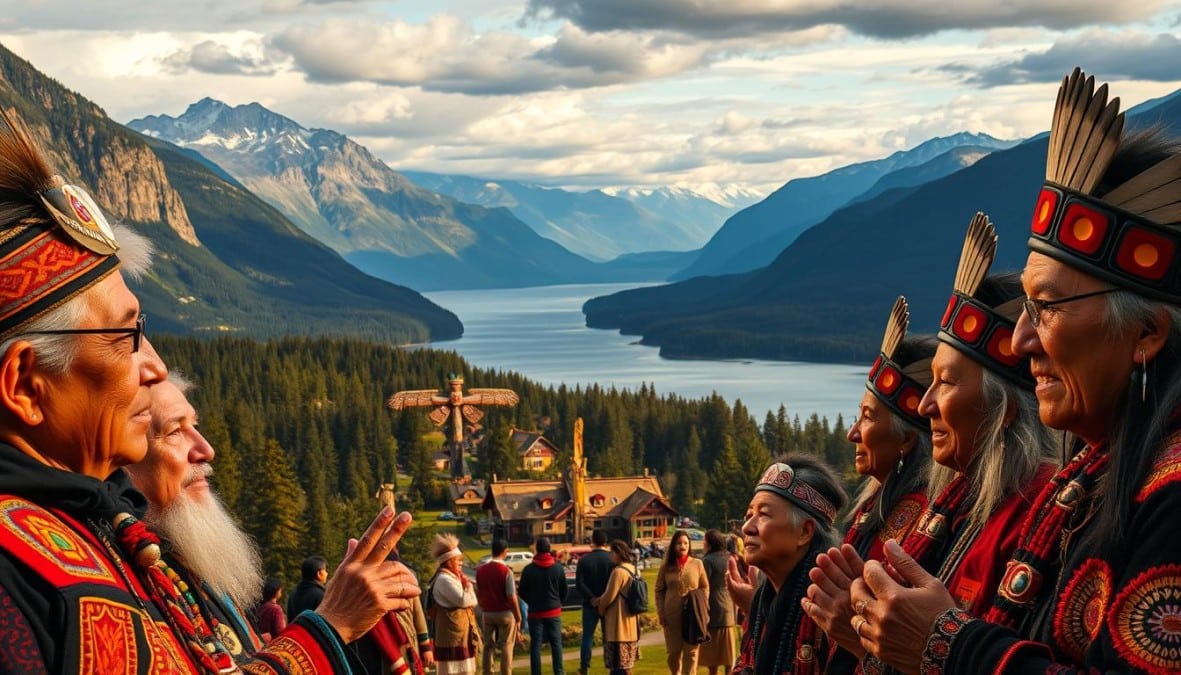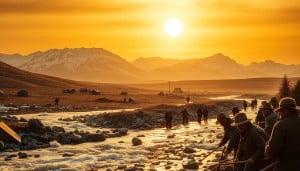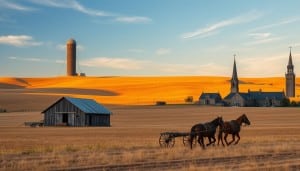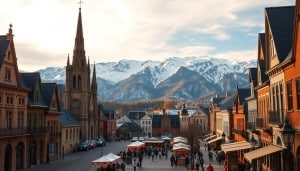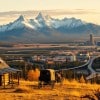Did you know that British Columbia’s history goes back over 14,000 years? This time goes way before anything was written down. It starts with the Indigenous people of British Columbia. Our province’s history is like a tapestry. It is full of stories from the first people and those who came from far away. Together, they made the diverse culture we love today.
Our province has a vast and important story. It has played a big part in our local and national history. It’s a story of resilience and exploration. It’s about coming together to make us a doorway to the Pacific and the world.
Looking through British Columbia’s history, we meet the First Nations. They have been here for thousands of years. Their care for the land is at our province’s heart. It shows us the huge role they have in our shared history.
We’ll see how things changed when Vancouver Island and British Columbia came together. This was after the Oregon boundary was decided. We’ll celebrate a big event in 1871. That’s when British Columbia joined the Canadian Confederation. It’s a moment of great pride.
We welcome you to learn about our past. It’s filled with interactions, challenges, and victories that made our province what it is today. This is our rich and ever-evolving heritage. We are all part of this ongoing story.
The Indigenous Peoples of British Columbia
The culture of British Columbia is deeply connected to its Indigenous roots. Long before Europeans came, many First Nations communities lived here. They thrived on the land, using its resources wisely.
These early peoples teach us valuable lessons about living with the earth. They show how to build strong communities. Their stories are essential for understanding British Columbia today.
Overview of First Nations Tribes
In British Columbia, over 30 languages are spoken. Each one tells the story of its people. From the Nuu-chah-nulth by the sea to the Ktunaxa in the mountains, each group adds to British Columbia’s rich history.
Cultural Practices and Languages
The Tsimshian people have a rich history dating back to 1892. They lived by the coast and depended on salmon. This fish was not just food but a key part of their culture and society.
Historical Significance
First Nations have deeply influenced British Columbia. Their ways of governing, spiritual beliefs, and social structures form the area’s diverse culture. They were the first environmentalists, caring for land and water.
Exploring the Indigenous history of British Columbia helps us understand the region’s social and environmental values.
European Contact and Exploration
We delve into the past, focusing on the European explorers who shaped British Columbia’s culture. This era connected different worlds, mainly through Spanish and British expeditions. They brought new tech and interacted with the indigenous people.
The Spanish were among the first Europeans in British Columbia, back in the late 18th century. Figures like Juan Francisco de la Bodega y Quadra explored the Pacific Northwest. They claimed these lands for Spain, setting the stage for the Nootka Crisis.
Soon after, British explorers like Captain James Cook arrived in 1778. He mapped the coast and started the fur trade, vital for the region’s economy. This led other British adventurers to explore the area’s rich resources.
These European explorers impacted the native populations in significant ways. Initial contacts varied from trade to confrontations. Here’s a comparison of key figures in British Columbia’s early explorations:
| Explorer | Expedition | Key Contributions |
|---|---|---|
| Juan José Pérez Hernández | 1774 Spanish Expedition | First recorded European contact with Haida Gwaii |
| Captain James Cook | 1778 British Expedition | Detailed charts of the North American northwest coastline |
| Juan Francisco de la Bodega y Quadra | 1775 Spanish Expedition | First detailed surveys and formal claims in the Pacific Northwest |
These explorations—both Spanish and British—show how a landscape and its people were transformed. The stories of these early European explorers are crucial. They help us understand British Columbia’s history and the Nootka Crisis.
The Fur Trade Era
The fur trade is a key part of British Columbia’s early history. It was defined by the relationship between the Hudson’s Bay Company and indigenous peoples. This era not only changed the economy but also laid the groundwork for later settlements and conflicts.
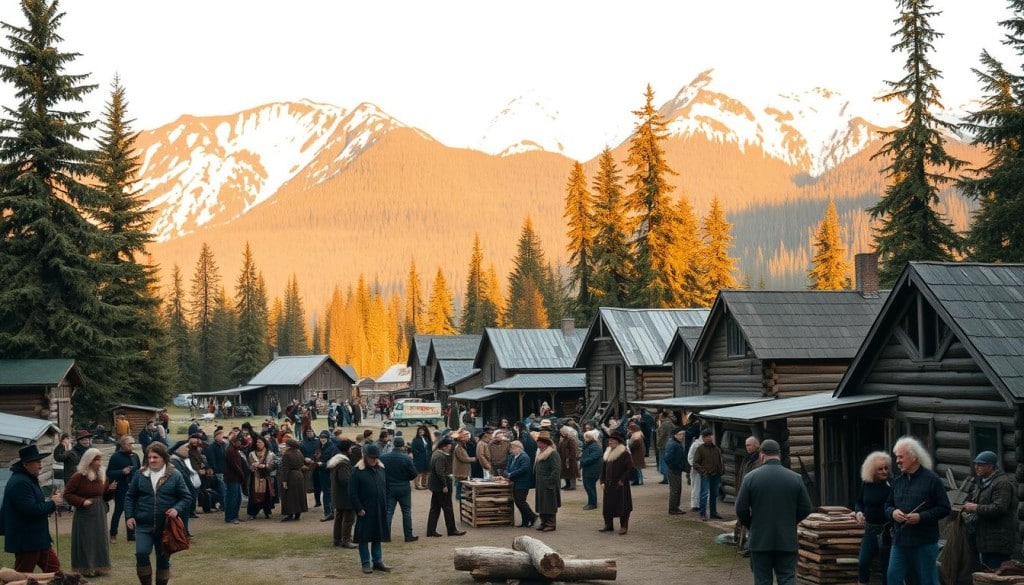
The Hudson’s Bay Company played a big role in the fur trade, setting up trading posts across British Columbia. These posts helped build strong economic and social ties with indigenous tribes. The tribes’ deep understanding of nature was critical.
- Fort Victoria turned into an important trading spot, especially after the British and American governments set the 49th parallel as the border. This move shifted the Columbia Department’s headquarters north, highlighting the growing value of these lands.
- Working together with local tribes was key to the fur trade’s success. It also led to rich cultural exchanges and reliance on each other during this period.
Exploring how the Hudson’s Bay Company managed the fur trade offers valuable lessons. It shows how economic goals and cultural respect and cooperation with indigenous peoples shaped early British Columbia.
Gold Rush and Population Growth
In 1858, gold found along the Thompson River started the Fraser River Gold Rush. This event was crucial in shaping British Columbia’s future. It wasn’t just an important moment in our history; it also caused a big jump in population and changed how people came to this area.
The Fraser River Gold Rush
Word about gold in the Fraser River’s sands spread fast. It brought thousands of prospectors from around the world. Suddenly, Victoria turned into a crowded tent city. It was the main entry for those hoping to find gold. This rush wasn’t just about searching for gold. It also sparked fast economic growth in the area.
Impact on Immigration and Settlement
The Fraser River Gold Rush had a big impact on who came to British Columbia. The chance to find gold brought many different people here. This mix of cultures has shaped our province’s identity even today. This growth led to lively, diverse communities across British Columbia. Here, old traditions and new ideas mix well.
The gold rush also led to new settlements, as some prospectors chose to stay. They started businesses and built their lives here, seeing this place as full of opportunities. Looking back, we see how these times changed our immigration and society.
Thinking about the Gold Rush reminds us of its big role in our history. It led to more people and new cultural mixes. It’s a key part of our past that shows our ancestors’ determination and how our community has grown.
Formation of the Colony of British Columbia
In 1866, British Columbia went through a big change. It joined with Vancouver Island to become one colony. This move was led by Governor James Douglas. It was important because it brought the area together and set up its future government.
This time was filled with big changes for colonial British Columbia. They were building a solid government structure. This was because many people were moving there for the Gold Rush. Governor James Douglas was a key leader during this time. He made deals with Indigenous communities and helped the economy grow. His work helped get British Columbia ready to join Canada.
| Year | Event | Impact on British Columbia |
|---|---|---|
| 1866 | Merger of Vancouver Island and British Columbia | Unified the administrative regions, creating a stronger colonial governance structure. |
| 1867-1871 | Preparations for Confederation | Structured the political landscape through improved institutions and economic strategies under Governor James Douglas’ guidance. |
Looking back at British Columbia’s history, the early decisions were crucial. The merger made government operations easier and strengthened the region’s identity. It paved the way for British Columbia to become an important part of Canada.
Indigenous Rights and Land Claims
The journey to recognize and address Indigenous land claims has been both complex and evolving. A key moment in this journey was the Calder case in British Columbia. It was a turning point that led to further agreements. These agreements aimed to make right the past and work together for the future.
It is important to understand these developments. They help us see the progress made and the hurdles that still stand.
The Calder Case and Its Importance
In 1973, the Calder case became a crucial moment for Indigenous rights in Canada, especially in British Columbia. It recognized Indigenous title to lands not given up by treaty or taken by war. The case not only backed the Nisga’a Nation’s rights but also set a benchmark for future talks and policies. This affects Indigenous land claims all over the country.
Comprehensive Land Claim Agreements
After the Calder case, comprehensive land claim agreements started to be used. They help address the rights and titles of Indigenous peoples in British Columbia and beyond. These agreements aim to clear up rights issues and build partnerships that respect Indigenous rights. They also help with the sustainable development of their ancestral lands.
Here is a quick look at how comprehensive land claim agreements progressed after the Calder case. This chart shows their impact and how they support Indigenous communities:
| Year | Agreement | Region |
|---|---|---|
| 1999 | Nisga’a Final Agreement | Northern British Columbia |
| 2008 | Tsilhqot’in Nation Framework Agreement | Central British Columbia |
| 2016 | Lheidli T’enneh Agreement-in-Principle | Prince George area |
These agreements are key steps toward justice, equity, and reconciliation. They show a commitment to legally respect and recognize Indigenous rights over their lands. By working together on land claims, we acknowledge historical rights. We also build partnerships for a stronger and more inclusive future.
Joining Confederation: A New Era
British Columbia stood at a crossroads in its history as it considered joining the Canadian Confederation. This move was set to change its political and economic scene forever. Let’s look at the key reasons for this decision and the political transformation that followed.
British Columbia’s march towards Confederation was driven by the lure of economic benefits and political steadiness. Leaders saw a chance to boost the economy with federal aid and connect better with the rest of Canada. Building the Canadian Pacific Railway was a key economic lure, creating a link with markets far and wide.
Economic and Political Implications
Entry into Confederation transformed British Columbia in big ways. The province gained from federal investments and new projects. Politically, it began playing a bigger role in Canada, making local and national policies match better. This was a start to the province and country evolving together politically.
- Enhanced economic stability through federal support
- Political integration into the broader Canadian framework
- Infrastructure developments, particularly in transportation
This crucial time did more than just define British Columbia’s role in Canada. It also laid the groundwork for growth and progress that continues to shape the province.
British Columbia in the 20th Century
The 20th century was key to British Columbia’s growth. It was a time of big changes in both economy and politics. The area was crucial during global events, like supporting wars and handling a booming population. British Columbia’s political evolution mixed with economic development , leading to a unique path. This path impacted its people and its place in Canada and the world.
Explore the era’s dynamics:
- World War I and II showed British Columbia’s key role and brought changes, affecting jobs and the economy.
- The following years saw shifts that shaped British Columbia’s economy. This included managing natural resources and navigating tech booms.
Now, let’s look at economic challenges and milestones of British Columbia’s 20th-century journey:
| Decade | Events and Achievements | Challenges |
|---|---|---|
| Early 1900s | Expansion of the railway and mining industries | Labor disputes and economic disparities |
| Post-WWII Period | Technological advancements and educational reform | Shifts in global trade patterns, need for diversification |
| Late 20th Century | Emergence of digital technology sector | Economic restructuring, unemployment issues |
Looking back helps us value British Columbia’s progress. We see how economic and political forces worked together to strengthen the province. It’s important we learn from our past. This way, we can make an even better future for British Columbia.
Modern British Columbia: Diversity and Economy
British Columbia stands as a vibrant symbol of diversity and economic strength today. It is shaped by its cultural heritage and home to many global communities. This cultural mix not only makes the province richer socially but also stronger economically. Let’s explore how British Columbia uses its cultural diversity and main industries as key economic drivers in today’s world.
Cultural Mosaic of British Columbia
In British Columbia, we treasure our multicultural setting. It has created a welcoming vibe that attracts talents from everywhere, enhancing our cultural wealth. Each community adds valuable perspectives to various fields, like the arts and business innovation. This creates a society diverse in thought and appearance.
Key Industries and Economic Drivers
British Columbia thrives beyond its vibrant cultural scene. It’s driven by several major industries, becoming a crucial part of Canada’s economy. Industries like forestry, mining, and fisheries, along with the rise of technology and sustainable energy, are foundational. These sectors drive British Columbia’s economy, blending innovation with environmental care.
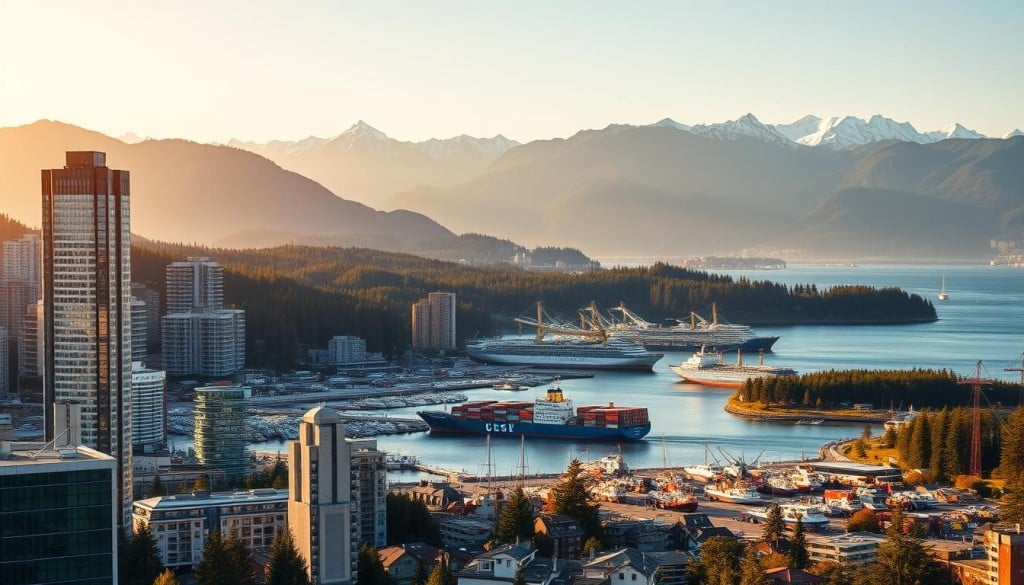
These industries create jobs and draw a talented workforce, which helps sustain our diverse communities. We are proud of our strong economy that values the environment and our cultural heritage. It sets a model for others around the globe.
As our population and economy expand, British Columbia stays ahead in innovation and cultural inclusivity. This propels Canada onto the global stage as a leader.
British Columbia’s Role in Canada and the World
British Columbia stands as a key player on the global stage, thanks to being the Pacific gateway. This goes beyond just location. It involves a major role in international trade and looking after our planet. Vancouver’s history shows growth in global reach and progress.
BC connects Canadian business with Asia-Pacific’s growing markets. It also focuses on sustainable growth and a greener economy. This shows BC’s commitment to a better future.
Environmental Stewardship
BC’s natural beauty is its pride, thanks to our community’s commitment to the environment. We all agree on the need to protect our landscapes and wildlife. To lead in conservation, action, and dedication are crucial.
We’ve embraced green technology and renewable energy. Strict environmental laws ensure we protect our future. This has made BC a leader in caring for our planet on a global level.
Major Trade Links and Pacific Gateway
The ports and trade centers in British Columbia are crucial for trade across the Pacific. Our excellent infrastructure and logistics make us key for international markets. Every ship we welcome shows the growth potential we have.
Vancouver has become a center for trade and cultural exchange. It’s where the Pacific gateway thrives. It promises a connected and prosperous future for all Canadians.

